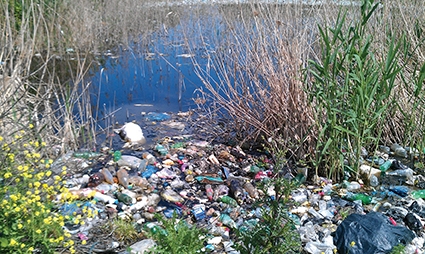Gurjaani Landfill Closes
The Solid Waste Management Company of Georgia (SWMC) has closed the Gurjaani landfill based on the Landfill Closure and Closure After-Care Plan developed in the frame of the program ‘Waste Management Technologies in Regions’ (WMTR).
The landfill was located on swampland and had been operating since 2000. In accordance with international standards, the landfill’s surface was graded, while the remaining waste was covered with clay soil.
The Gurjaani disposal area was located in the municipality of Gurjaani along the Gurjaani-Jabukiani-Lagodekhi road. The landfill, which was built during the Soviet era, did not comply with modern standards and represented a threat to human health and the environment.
Giorgi Shukhoshvili, the Director of the SWMC explains that the waste disposal area of Gurjaani was disorganized and unfenced, attracting unwelcome animals to forage. As such, it had a negative impact on both the local population and animal health. Additionally, the surrounding territories of the area were used for agricultural purposes.
To help the company properly close the landfill, USAID-funded program WMTR, which is implemented by the International City/Country Management Association (ICMA) and the Caucasus Environmental NGO Network (CENN), prepared a landfill closure and closure after-care plan where a hydrogeological survey and other types of studies were conducted on the area to evaluate the situation and develop relevant a plan. “The aim of the plan was to present the design basis and activities that were utilized to minimize the environmental impact of the disposal area. The closure of the landfill started in February of this year and lasted a few months,” said Shukhoshvili, adding that waste from Gurjaani Municipality is now disposed of at refurbished landfills in Telavi and Dedoplistskaro.
It should be noted that the exact date when disposal operations began on the landfill are unknown and there is little information on the total quantity of solid waste delivered to the site during its operation. However, it is known that waste delivered here was regularly burned.
As Shukhoshvili explains, the closure works included drying swamp areas within the landfill, shaping the landfill surface, flattening waste by levelling and covering it with clay soil.
According to the new Waste Management Code, Georgia should close all old landfills that do not comply with international standards and create new, regional, sanitary landfills. Since 2015, the SWMC has closed 14 municipal landfills and plans on closing Bakuriani, Manglisi, Martvil, Borjomi and Tsalka Municipal landfills by the end of 2016.
Baia Dzignadze












